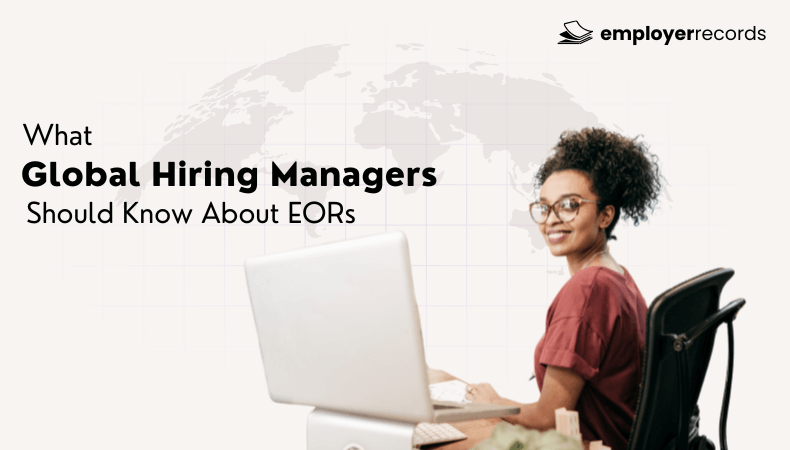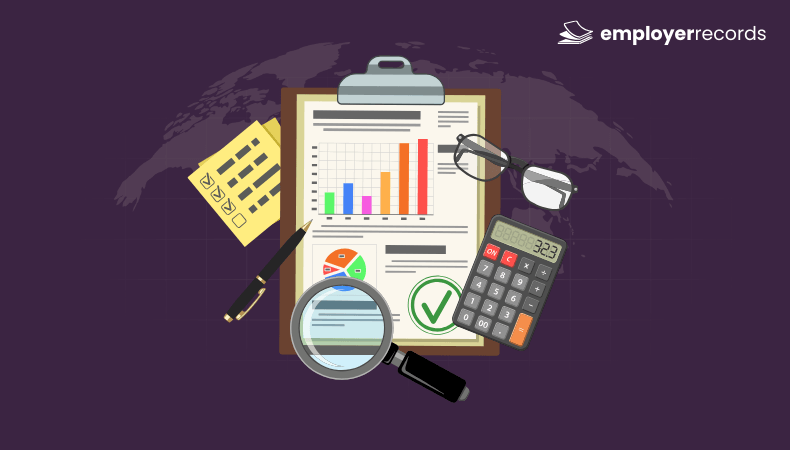Transitioning from independent contractors to an Employer of Record (EOR) model offers numerous advantages, including enhanced compliance, improved talent retention, and streamlined international expansion.
Partnering with a reputable EOR provider, companies can effectively navigate this transition and position themselves for sustained growth. An EOR assumes responsibility for legal and administrative employment tasks, such as payroll, taxes, benefits, and compliance with local labor laws.
This ensures adherence to local labor laws and tax regulations, reducing the risk of misclassification and associated penalties. Also, offering contractors the stability of formal employment through an EOR can increase job satisfaction and loyalty.
Employees benefit from structured contracts, consistent payroll, and access to benefits, making them more likely to remain with the company long-term.
For businesses looking to expand internationally, EORs facilitate hiring in new markets without the need to establish a legal entity in each country. This approach accelerates market entry and ensures compliance with local employment laws.
By following a structured approach and collaborating with a reliable EOR provider, companies can seamlessly transition their workforce, ensuring compliance, enhancing employee satisfaction, and supporting long-term growth objectives.
Comparison Table: Contractors vs EOR Model
| Feature | Independent Contractors | EOR Model Employees |
|---|---|---|
| Legal Responsibility | Company liable | EOR assumes responsibility |
| Compliance Risk | High | Low |
| Payroll Consistency | Variable | Structured |
| Access to Benefits | Limited/None | Comprehensive (via EOR) |
| Employment Stability | Uncertain | Secure with formal contracts |
| Ease of Global Hiring | Complex, risky | Streamlined via EOR |
Why Transition From Contractors To An EOR Model?
Transitioning from independent contractors to an Employer of Record (EOR) model is a strategic move that addresses the complexities of global workforce management. As businesses expand internationally, they often face challenges related to compliance with diverse labor laws, tax regulations, and employment standards.
An EOR simplifies this process by assuming legal responsibility for employment, allowing companies to focus on their core operations while ensuring adherence to local regulations.
Moreover, relying on independent contractors can lead to issues such as misclassification risks, inconsistent work quality, and difficulties in managing long-term projects.
By transitioning to an EOR model, companies can offer structured employment contracts, access to benefits, and job security, which enhances talent retention and fosters a more committed workforce.
In the following sections, we delve deeper into the specific advantages of adopting an EOR model and provide a step-by-step guide to facilitate a smooth transition.
1. Reduce Legal Risks by Shifting Compliance to an EOR
Transitioning to an Employer of Record (EOR) model significantly mitigates compliance risks for companies. An EOR takes on responsibilities such as payroll administration, tax filings, and benefits management while ensuring adherence to local labor laws.
This proactive management reduces the risk of misclassification issues, which can lead to legal penalties and fines, and helps companies operate smoothly across different regulatory environments.
Misclassification issues can lead to significant financial and legal consequences. According to ADP, companies risk penalties averaging $25,000–$50,000 per misclassification incident in the U.S., not to mention potential back taxes and reputational damage. By partnering with an EOR, businesses can proactively avoid these risks through compliant employment practices.
By shifting these responsibilities to a trusted EOR partner, businesses can concentrate on core operations without the constant worry of remaining non-compliant.
The EOR provides expertise in navigating local employment regulations and labor standards, reducing administrative burdens, and ensuring that all contractual engagements are properly managed. This not only secures the company legally but also promotes a stable and positive work environment.
2. Improve Talent Retention with Stable Employment
Offering contractors the stability of formal employment through an EOR significantly enhances their job satisfaction and loyalty. When contractors become full-time employees, they gain structured contracts, predictable payrolls, and comprehensive benefits, which provide not only financial security but also a clear career trajectory.
This added stability fosters trust in the organization, making them feel valued and supported. Moreover, this transition reduces administrative burdens by shifting compliance and HR tasks to the EOR, allowing employees to focus on their work.
This structured, supportive approach contributes to long-term retention by promoting a positive work environment and boosting overall employee morale.
3. Simplify International Hiring and Expansion with an EOR
For businesses looking to expand internationally, EORs enable companies to tap into new markets without the costly and time-consuming process of establishing a legal entity in each country.
Speed is critical when expanding into new regions.
A Globalization Partners report found that 74% of companies using EORs entered new markets 3–4 months faster compared to establishing local entities. This agility allows organizations to capture market opportunities without administrative delays.
This agile approach allows firms to bypass regulatory complexities and instantly access local talent pools, accelerating market penetration. Moreover, partnering with an EOR assures compliance with diverse local employment laws.
By managing payroll, benefits, and regulatory obligations, EOR providers minimize legal risks and administrative burdens. This streamlined strategy not only speeds up market entry but also empowers companies to focus on strategic growth and operational excellence in global markets.
Step-by-Step Guide: How to Transition from Contractors to an EOR Model
Transitioning to an Employer of Record (EOR) model involves a transformative process that redefines the way your organization manages its workforce, moving from independent contractors to formal employees while ensuring full legal compliance.
The following step-by-step guide offers actionable insights, from assessing your current team composition to establishing a seamless onboarding process, that will help your company navigate this shift efficiently and confidently.
Contractor to EOR Transition Process

Step 1: Audit Your Workforce to Identify Contractor Roles
Begin by evaluating your current contractor engagements to identify roles that would benefit from formal employment. Assess factors such as the duration of engagement, control over work, and integration into company operations to determine potential misclassification risks.
What Are the Key Features?
- Detailed Engagement Analysis: Review each contractor’s role and engagement duration to understand their level of involvement.
- Control Assessment: Evaluate the degree of control your organization exerts over the contractor’s work to identify signs of potential misclassification.
- Operational Integration: Examine how embedded contractors are within core operations, which can highlight the need for formal employment.
- Risk Documentation: Record any indicators of misclassification risk, which can then be compared against compliance standards.
- Baseline Establishment: Set a reference point for future workforce reclassifications and compliance audits.
Why is it Important
Conducting a workforce audit is essential as it helps uncover hidden risks of misclassification and non-compliance, safeguarding the company from future legal and financial penalties.
It additionally provides a clear picture of where transitioning contractors to an EOR model will yield the most benefit, ultimately enhancing workforce stability and supporting strategic growth initiatives.
Step 2: Choose the Right EOR Partner for Your Business
Choose an EOR provider with expertise in your target regions and industries. Ensure they offer comprehensive services, including payroll management, benefits administration, and compliance support. Review their track record and client testimonials to gauge reliability.
What Are the Key Features?
- Global Presence and Local Expertise: Ensure the EOR has a strong presence in the countries where you operate and possesses in-depth knowledge of local employment laws and cultural nuances.
- Comprehensive Compliance Support: The EOR should have a proven track record of navigating complex tax regulations and employment laws without legal penalties.
- Robust Payroll and Benefits Administration: Look for partners that offer reliable payroll processing, and benefits management, and that handle local tax obligations efficiently.
- Scalability: Choose an EOR that can adapt to your company’s growth, whether it’s hiring additional employees or expanding into new markets.
- Strong Reputation and Client Feedback: Research the EOR’s reputation through client testimonials and case studies to assess their reliability and service quality.
Why Choosing the Right EOR Partner is Crucial
Selecting the right EOR partner ensures your company avoids legal pitfalls and benefits from a seamless employment experience for your team.
A reliable EOR acts as a strategic ally, handling complex administrative tasks while you focus on scaling globally, reducing risk, and enhancing your employer brand in new markets.
Step 3: Communicate the EOR Transition to Your Contractors
Engage in transparent discussions with your contractors about the transition. Highlight the benefits of moving to an EOR model, such as job security, access to benefits, and career development opportunities. Address any concerns they may have to facilitate a smooth transition.
What Are the Key Features?
- Clear and Transparent Communication: Clearly explain the reasons for the transition and the benefits it brings.
- Highlight Key Benefits: Emphasize job security, access to benefits, and career advancement opportunities under the EOR model.
- Provide Support for Concerns: Actively address and resolve any concerns or doubts contractors may have about the transition.
- Offer Personalized Solutions: Tailor discussions to individual contractor needs and preferences to foster trust.
- Be Proactive in Follow-ups: Regularly check in with contractors throughout the transition process to ensure ongoing support.
Why is Communication Important?
Clear communication helps contractors understand the rationale behind the transition, reducing resistance and promoting cooperation. It also reassures them that their well-being and job satisfaction are prioritized, which can boost morale and commitment.
Open dialogue ensures any concerns are swiftly addressed, fostering a smooth transition and retaining top talent.
Step 4: Create Legally Compliant Employment Contracts
Work with your EOR partner to draft employment contracts that comply with local laws and reflect agreed-upon terms. Ensure that all necessary documentation, such as tax forms and benefit enrollments, is completed accurately.
What Are the Key Features?
- Compliance with Local Laws: Employment contracts must adhere to the legal requirements of the country or region where the employee is based.
- Clear Terms and Conditions: Contracts should clearly outline the employee’s role, responsibilities, compensation, and benefits.
- Tax and Benefit Documentation: Accurate completion of tax forms and enrollment in benefits programs is necessary to ensure compliance with relevant regulations.
- Duration and Termination Clauses: Clearly defined contract duration and conditions for termination or resignation help manage expectations.
- Confidentiality and Non-compete Clauses: These clauses protect the business and its intellectual property from potential risks associated with employee departures.
Why is it Important?
Formalizing employment agreements ensures both parties are aligned on the terms of employment, reducing the risk of misunderstandings and legal disputes.
It also confirms compliance with labor laws and tax regulations, which can protect the business from costly penalties. Finally, comprehensive contracts establish a solid foundation for positive, long-term employee relationships, offering clarity and security to both the employer and employee.
Step 5: Monitor, Support, and Optimize the EOR Transition
After the transition, maintain open lines of communication with your new employees. Provide support during the onboarding process and regularly check in to address any issues or concerns. Collaborate with your EOR partner to ensure ongoing compliance and employee satisfaction.
What Are the Key Features?
- Regular Check-ins: Consistent follow-ups with employees to address concerns or feedback during the early stages of employment.
- Onboarding Support: Providing clear instructions and resources during the onboarding process to ensure a smooth integration into the company.
- Ongoing Compliance Monitoring: Continuously collaborating with your EOR partner to ensure that all employment regulations and benefits are maintained.
- Employee Engagement: Encouraging open communication channels for employees to express needs, challenges, and feedback.
- Dedicated Support Channels: Offering employees access to HR and EOR partner resources to address questions about payroll, benefits, and work-related issues.
Why is it Important?
Monitoring and supporting the transition is essential to ensure that employees feel valued and confident in their new roles, helping them adjust to the formal employment structure.
Addressing concerns proactively reduces the risk of employee dissatisfaction and potential turnover. Moreover, maintaining an open dialogue and ensuring ongoing compliance with labor laws fosters a positive workplace culture and minimizes legal or operational risks.
Conclusion
Transitioning from independent contractors to an Employer of Record (EOR) model offers numerous advantages, including enhanced compliance, improved talent retention, and streamlined international expansion. By partnering with a reputable EOR provider, companies can effectively navigate this transition and position themselves for sustained growth.
An EOR assumes responsibility for legal and administrative employment tasks, such as payroll, taxes, benefits, and compliance with local labor laws. This ensures adherence to local labor laws and tax regulations, reducing the risk of misclassification and associated penalties.
Moreover, offering contractors the stability of formal employment through an EOR can increase job satisfaction and loyalty. Employees benefit from structured contracts, consistent payroll, and access to benefits, making them more likely to remain with the company long-term.
For businesses looking to expand internationally, EORs facilitate hiring in new markets without the need to establish a legal entity in each country. This approach accelerates market entry and ensures compliance with local employment laws.
By following a structured approach and collaborating with a reliable EOR provider, companies can seamlessly transition their workforce, ensuring compliance, enhancing employee satisfaction, and supporting long-term growth objectives.







